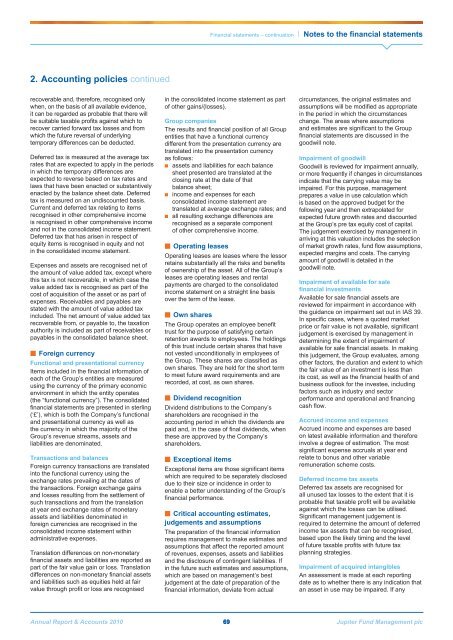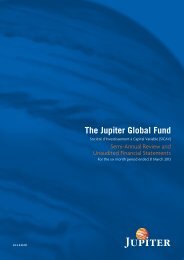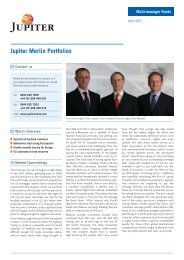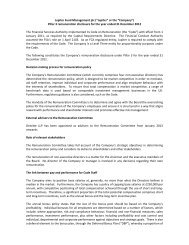Jupiter Annual Report 2010 - Jupiter Asset Management
Jupiter Annual Report 2010 - Jupiter Asset Management
Jupiter Annual Report 2010 - Jupiter Asset Management
Create successful ePaper yourself
Turn your PDF publications into a flip-book with our unique Google optimized e-Paper software.
Financial statements – continuation | Notes to the financial statements<br />
2. Accounting policies continued<br />
recoverable and, therefore, recognised only<br />
when, on the basis of all available evidence,<br />
it can be regarded as probable that there will<br />
be suitable taxable profits against which to<br />
recover carried forward tax losses and from<br />
which the future reversal of underlying<br />
temporary differences can be deducted.<br />
Deferred tax is measured at the average tax<br />
rates that are expected to apply in the periods<br />
in which the temporary differences are<br />
expected to reverse based on tax rates and<br />
laws that have been enacted or substantively<br />
enacted by the balance sheet date. Deferred<br />
tax is measured on an undiscounted basis.<br />
Current and deferred tax relating to items<br />
recognised in other comprehensive income<br />
is recognised in other comprehensive income<br />
and not in the consolidated income statement.<br />
Deferred tax that has arisen in respect of<br />
equity items is recognised in equity and not<br />
in the consolidated income statement.<br />
Expenses and assets are recognised net of<br />
the amount of value added tax, except where<br />
this tax is not recoverable, in which case the<br />
value added tax is recognised as part of the<br />
cost of acquisition of the asset or as part of<br />
expenses. Receivables and payables are<br />
stated with the amount of value added tax<br />
included. The net amount of value added tax<br />
recoverable from, or payable to, the taxation<br />
authority is included as part of receivables or<br />
payables in the consolidated balance sheet.<br />
■■Foreign currency<br />
Functional and presentational currency<br />
Items included in the financial information of<br />
each of the Group’s entities are measured<br />
using the currency of the primary economic<br />
environment in which the entity operates<br />
(the “functional currency”). The consolidated<br />
financial statements are presented in sterling<br />
(‘£’), which is both the Company’s functional<br />
and presentational currency as well as<br />
the currency in which the majority of the<br />
Group’s revenue streams, assets and<br />
liabilities are denominated.<br />
Transactions and balances<br />
Foreign currency transactions are translated<br />
into the functional currency using the<br />
exchange rates prevailing at the dates of<br />
the transactions. Foreign exchange gains<br />
and losses resulting from the settlement of<br />
such transactions and from the translation<br />
at year end exchange rates of monetary<br />
assets and liabilities denominated in<br />
foreign currencies are recognised in the<br />
consolidated income statement within<br />
administrative expenses.<br />
Translation differences on non-monetary<br />
financial assets and liabilities are reported as<br />
part of the fair value gain or loss. Translation<br />
differences on non-monetary financial assets<br />
and liabilities such as equities held at fair<br />
value through profit or loss are recognised<br />
in the consolidated income statement as part<br />
of other gains/(losses).<br />
Group companies<br />
The results and financial position of all Group<br />
entities that have a functional currency<br />
different from the presentation currency are<br />
translated into the presentation currency<br />
as follows:<br />
■■<br />
■■<br />
■■<br />
assets and liabilities for each balance<br />
sheet presented are translated at the<br />
closing rate at the date of that<br />
balance sheet;<br />
income and expenses for each<br />
consolidated income statement are<br />
translated at average exchange rates; and<br />
all resulting exchange differences are<br />
recognised as a separate component<br />
of other comprehensive income.<br />
■■Operating leases<br />
Operating leases are leases where the lessor<br />
retains substantially all the risks and benefits<br />
of ownership of the asset. All of the Group’s<br />
leases are operating leases and rental<br />
payments are charged to the consolidated<br />
income statement on a straight line basis<br />
over the term of the lease.<br />
■■Own shares<br />
The Group operates an employee benefit<br />
trust for the purpose of satisfying certain<br />
retention awards to employees. The holdings<br />
of this trust include certain shares that have<br />
not vested unconditionally in employees of<br />
the Group. These shares are classified as<br />
own shares. They are held for the short term<br />
to meet future award requirements and are<br />
recorded, at cost, as own shares.<br />
■■Dividend recognition<br />
Dividend distributions to the Company’s<br />
shareholders are recognised in the<br />
accounting period in which the dividends are<br />
paid and, in the case of final dividends, when<br />
these are approved by the Company’s<br />
shareholders.<br />
■■Exceptional items<br />
Exceptional items are those significant items<br />
which are required to be separately disclosed<br />
due to their size or incidence in order to<br />
enable a better understanding of the Group’s<br />
financial performance.<br />
■■Critical accounting estimates,<br />
judgements and assumptions<br />
The preparation of the financial information<br />
requires management to make estimates and<br />
assumptions that affect the reported amount<br />
of revenues, expenses, assets and liabilities<br />
and the disclosure of contingent liabilities. If<br />
in the future such estimates and assumptions,<br />
which are based on management’s best<br />
judgement at the date of preparation of the<br />
financial information, deviate from actual<br />
circumstances, the original estimates and<br />
assumptions will be modified as appropriate<br />
in the period in which the circumstances<br />
change. The areas where assumptions<br />
and estimates are significant to the Group<br />
financial statements are discussed in the<br />
goodwill note.<br />
Impairment of goodwill<br />
Goodwill is reviewed for impairment annually,<br />
or more frequently if changes in circumstances<br />
indicate that the carrying value may be<br />
impaired. For this purpose, management<br />
prepares a value in use calculation which<br />
is based on the approved budget for the<br />
following year and then extrapolated for<br />
expected future growth rates and discounted<br />
at the Group’s pre tax equity cost of capital.<br />
The judgement exercised by management in<br />
arriving at this valuation includes the selection<br />
of market growth rates, fund flow assumptions,<br />
expected margins and costs. The carrying<br />
amount of goodwill is detailed in the<br />
goodwill note.<br />
Impairment of available for sale<br />
financial investments<br />
Available for sale financial assets are<br />
reviewed for impairment in accordance with<br />
the guidance on impairment set out in IAS 39.<br />
In specific cases, where a quoted market<br />
price or fair value is not available, significant<br />
judgement is exercised by management in<br />
determining the extent of impairment of<br />
available for sale financial assets. In making<br />
this judgement, the Group evaluates, among<br />
other factors, the duration and extent to which<br />
the fair value of an investment is less than<br />
its cost, as well as the financial health of and<br />
business outlook for the investee, including<br />
factors such as industry and sector<br />
performance and operational and financing<br />
cash flow.<br />
Accrued income and expenses<br />
Accrued income and expenses are based<br />
on latest available information and therefore<br />
involve a degree of estimation. The most<br />
significant expense accruals at year end<br />
relate to bonus and other variable<br />
remuneration scheme costs.<br />
Deferred income tax assets<br />
Deferred tax assets are recognised for<br />
all unused tax losses to the extent that it is<br />
probable that taxable profit will be available<br />
against which the losses can be utilised.<br />
Significant management judgement is<br />
required to determine the amount of deferred<br />
income tax assets that can be recognised,<br />
based upon the likely timing and the level<br />
of future taxable profits with future tax<br />
planning strategies.<br />
Impairment of acquired intangibles<br />
An assessment is made at each reporting<br />
date as to whether there is any indication that<br />
an asset in use may be impaired. If any<br />
<strong>Annual</strong> <strong>Report</strong> & Accounts <strong>2010</strong> 69 <strong>Jupiter</strong> Fund <strong>Management</strong> plc








